Figures of entanglement
By way of introduction
Topologies of entanglement, from post-colonial theory, eco-politics to quantum physics, have become a common figure of speech in recent times. We may well ask, then, whether in the current, transitional period of social distancing, where intermingling, contact and proximity have become anathema, the notion of entanglement is already accruing a new set of connotations, regardless whether we understand it in a concrete or metaphorical sense. In the following, I offer a few, loosely associated threads which may provide a way into thinking through this question. Nothing more, nothing less…
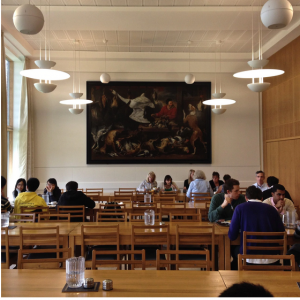
The Fowl Market
A few weeks before the coronavirus would rear its head, an English newspaper carried a report that students had successfully petitioned Cambridge University to remove a seventeenth-century still life painting from their dining hall at Hughes Hall.[1] The offense-giving work, The Fowl Market, was a work shop copy of an original by Frans Snyders. With its rather florid depiction of slain wild life, the work appears to have ruined the appetite of too many students. Indeed, to contemporary tastes the painting may well be found intemperate in its depiction of a meat stall, with its butcher standing behind a mound of game animals, their entangled limbs slumping towards the floor while various species of fowl, including a rather incongruous swan with splayed wings, are strung from a beam above. To the side a ravenous dog, excited by these spoils of the hunt, rears itself on its hind legs. “Some diners felt unable to eat because it was on the wall,” a spokeswoman from Cambridge University explained. “People who don’t eat meat found it slightly repulsive. They asked for it to come down.”
The painting had been on a loan from the Fitzwilliam and the newspaper did not reveal how long the lurid painting had been displayed in the dining hall or who had the bright idea to hang it there in the first place. After a kind of slow burn, however, the figurative excesses of Snyders’ painting appear to have finally ignited the kind of diner’s revolt that Mark Rothko had yearned for so many decades earlier, but was unable to achieve with his abstract murals, which were commissioned for the high-end Four Seasons restaurant in the New York Seagram building. As the American artist allegedly confided to an acquaintance: “I accepted this assignment as a challenge, with strictly malicious intentions. I hope to paint something that will ruin the appetite of every son of a bitch who ever eats in that room. If the restaurant would refuse to put up my murals, that would be the ultimate compliment. But they won’t. People can stand anything these days.” On top of objecting to the fact that gustatory pleasure, not to mention the sheer digestion of food, might distract from the contemplation of his work, Rothko expressed a particular dislike of the elite clientele of the Four Seasons restaurant , which was the home of the prototypical ‘power lunch.’ Rothko reckoned if the patrons were willing to spend so much on a meal, they would never become collectors of his art. This seems to have been a miscalculation on his part, however he was never able to test how ‘nauseating’ the effect of his abstract painting might be on this high society crowd as he finally withdrew from the commission and the murals were never installed in the restaurant.
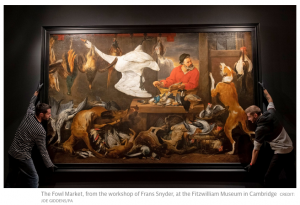
In the case of the Snyders painting, the university decided to return The Fowl Market to the Fitzwilliam museum. Soon thereafter the painting found a new, more accommodating environment in an exhibition, organized by the Fitzwilliam, called “Feast & Fast: The Art of Food in Europe, 1500-1800,” which opened on November 26, 2019. According to the museum’s press release the show aimed to “tease out many contemporary and controversial issues—such as the origins of food and food security, overconsumption in times of austerity, and our relationship with animals and nature—thereby linking the past with our present, and encouraging visitors to question and rethink our relationship with food.” Whereas the indiscriminate mingling of the dead corpses of beast and fowl in the Snyders painting offers to contemporary viewers a ready metaphor of human’s rapacious relation to nature, the exhibition’s website declared that the “colossal canvas is a fantasy of nature’s bounty for its urban Flemish viewers.” Continuing with a random enumeration of all the depicted animals: “Deer, wild boar, hares, swan, pheasant, partridge, peacock, woodcock, kingfisher, skylark, blackbird, black grouse, bittern, snipe, and a string of songbirds, including bullfinch, chaffinch, and brambling,” stating that they “are just some of the species that can be identified, thanks to their remarkably accurate portrayal, and which ended up on elite tables.” Indeed, in terms of cultural history, Snyders’ painting would have been worthy of the Four Seasons, as it did not portray any random farmer’s market, but a butcher’s stall catering precisely to an emergent, bourgeois class of ‘conspicuous consumers.’ This was clearly no everyday fare, but an assortment of wild that were destined for display on a Baroque feasting table, decked with ornate table ware and “crowned with high status hunting birds”, as we can read on the museum’s website. “Feast & Fast” even included the recreation of such a fanciful spread, with its off-putting mixture of the culinary and the taxidermic, presenting a stuffed swan and peacock perched atop meat pies.
Hypermarchés
Considering that Snyders’ painting depicts a wild market, another set of associations besides that of vegan outrage or elite dining rituals now come to mind as well. In the past months we have been fed a constant stream of sensationalist as well as alarmist reports in about the so-called ‘wet markets’ in Asia. In the Western imagination these marketplaces have been transmuted from an exotic, touristic spectacle into a virulent breeding ground of disease. In thinly veiled racist terms, some Western commentators have decried the ‘unusual‘ eating habits of other countries, which leads to the reckless ‘intermingling’ of animal species in wet markets. (Apparently, these commentators had not been able to visit the “Feast and Fast” exhibition before it was closed down due to the corona epidemic or they may have come to other cultural insights). There is no doubt, as virologists have pointed out, that the indiscriminate mixing of domestic and wild animals creates favorable conditions for the emergence of zoonotic diseases, which can jump from animal to animal to… human. But whereas there are valid reasons for concern about the state of hygiene in certain wet markets (and, in general, wild and domestic animals should be kept separate), many caveats need to be put in place. First of all, as some of the more careful reports have stated, the generic reference to ‘wet markets’ fails to make a distinction between regular farmers’ markets, live animal markets and wildlife markets. The comprehensive term ‘wet market’ is derived, of course, from the ice packaging and spraying of cold water to conserve the fresh produce, but this association of ‘wetness’ with ‘freshness’ has been converted in the media into its opposite, raising the specter of an uncontainable flow of germ-ridden effluvia.
The frantic calls to close down all ‘wet markets’ is completely off the mark. As one Bloomberg reporter, David Fickling, has recently remarked, we need to place things in perspective: “Hold the outrage” is his response to those, like Senator Lindsay Graham, who clamor for China to pay “big time” for the pandemic outbreak.[2] To be sure, if there is one type of market that calls for increased food safety regulation, it would be the wild market, which the WHO has acknowledged. But, again, this distinction is not always made and it is the wet market in general, rather than the wild market, that has become etched into the public mind in the shape of the now infamous Huanan Seafood Wholesale Market in Wuhan, which may have enabled the jumping of the corona virus from animals to humans. Yet, not all wet markets are, as Fickling argues, “cesspits of disease” and, moreover, they perform an essential social service, providing a cheaper source of fresh produce than one finds in the Asian supermarkets. Although the wet markets appear to be slowly losing ground to supermarkets in China, Fickling observes that if they show “resilience as suppliers of fresh goods, it’s precisely because consumers regard them as a healthier and more sustainable alternative.” And as to be expected, this statement did not take long to provoke a new outbreak of the type of “outrage,” which Fickling was trying to dampen. A case in point being a post on the far-right website the Daily Wire, which scored its point more by its choice of image than by its commentary, which consisted mostly of a montage of quotes.[3]
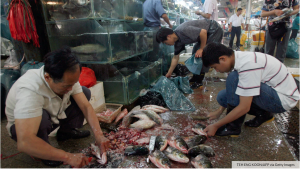
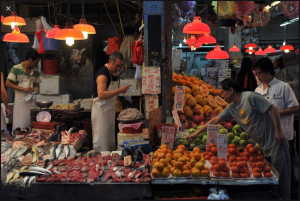
Aaron Tam/AFP/Getty Images
It is illuminating to compare the images that accompanied both online dispatches. Indeed, Western press articles about the wet markets are invariably accompanied by two contrasting types of image. One which speaks to our fear of contagion, which is expressed through indications of bodily proximity and commingling, which Fickling sarcastically describes as the nightmarish imagination of the wet market as a site where “a range of common and exotic animals mix together while bodily fluids flow freely.” Thus, the Daily Wire, according to proper form, re-enlists an often-reproduced image showing two fishmongers filleting fish on the moist floor or the market, the bloody entrails spread around in a clear breach of hygienic standards. Taken at a close, slanted angle under the harsh glare of fluorescent lighting, this picture exploits foreshortening to a startling degree. Clearly, its pictorial effect could not be farther removed than the strictly frontal composition of Snyders’ painting, which is its more ‘classical’ aspect in spite of the tangled bodies in the foreground. On the other hand, Fickling’s own article is illustrated by an image that is equally strong in its ‘rhetorical’ nature, if pursuing the opposite aim. Here, the wet market is shown in a more benign light, its market stalls even mimicking the balanced, frontal composition of Snyders, minus the writhing forms that revolve around the butcher’s table, with the large white swan pointing as arrow in one direction, while the animals below tumble in another. No such frenzied mass in the photograph; rather, we can admire the neatly sorted rows of colorful produce, with the displays of fish and fruit adjoined, but not touching. The whole is suffused by the warm glow of overhanging lamps, which even pick up the pervasive red accents in the image, a color which in Snyders’ painting is reserved for the butcher’s shirt and, making a metaphor literal, is spilled as blood on the floor in the fish market photograph. Whereas, the Bloomberg image bespeaks the ‘freshness’ of the ‘wet’ market, the latter brands the site as unsanitary and, by extension, promotes the ‘modern convenience’ of the packaged and processed foods of the supermarket. Meanwhile, we are reading reports that the safety of the food destined for supermarkets cannot be guaranteed as the testing labs are overwhelmed by the current demand for corona virus testing.
Hyper-neo-modernists
We don’t know for sure, and probably will never know if the Huanan market was the epicenter of the pandemic. And even so, what would it mean to declare it to be ground zero? Is it not equally fair to say that the corona virus outbreak is a symptom of the continuing degradation of the environment of global capitalism, its extractionist logic bringing various forms of life which otherwise inhabit quite different ecological niches into intimate contact? This, of course, is another common thread in current discussions about the pandemic. Already in the January 28 issue of the New York Times, David Quammen opinions that we ourselves have “made the Coronavirus epidemic,” which did not pre-empt Trump’s cynical attempts to racialize the virus. To be clear, Quammen is not spinning the kind of conspiracy theory favored by the far-right that claims that the virus is ‘human-made’ and has ‘escaped’ from a military germ lab. Rather, the guilt carried by the collective is that of all human agents that participate, voluntarily or not, in a globalized economic system of extraction. As Quammen writes, we “disrupt ecosystems, and we shake viruses loose from their natural hosts. When that happens, they need a new host. Often, we are it.” Yet, this collective we is clearly marked by its own rules of inclusion and exclusion, its own distribution of winners and losers, and, in fact, the fall out of the economic crises, thus far, is only to increase the inequities of wealth distribution and access to health care. To the extent that Snyders’ Fowl Market catered to a newly emergent mercantile elite and thus marks the historical emergence of a world market system, its snarled and twisted heap of flesh makes a mockery of our new-found anxiety about social distancing and those hopeful claims that ‘nature’ is ‘healing itself’ due to the temporary withdrawal of the human footprint.
Giorgio Agamben’s response, for instance, provoked one of the larger controversies, identifying the shutdown as one more brutal confirmation of a bio-political regime in which a general state of exception has come to rule the contemporary commonwealth: “Every state of exception—this time around it is a health-related one [suggesting, therefore, that this epidemic is a convenient means to an end, as in former days, terrorist attacks were]—is also always a laboratory in which new political and social situations are tried out that still await humanity.” In a society consumed by a fear of the loss of bare life, social distancing becomes a (self-)enforced imperative – noli me tangere as a generalized, sacral duty – and such a ‘we’ will lack a public body, it is a “diluted mass grounded upon a prohibition, which therefore is particularly compact and passive.”[4] Love one’s neighbor by avoiding contact. Yet, to the extent, that social distancing is just one more symptom of a generalized, bio-political state of exception, it begs the question, as several others have argued, what alternative there is besides downplaying the epidemic as an ‘all-too-convenient’ event.
Somewhat more in keeping with what I have discussed above is Bruno Latour’s comment, rendered before the viral outbreak, yet all the more relevant today, that bio-politics has been extended to all living things, not just human bodies, in the context of what he has called a universal ”crisis of engendering.” Whereas Agamben reads a dystopic message into the current crisis, Latour, takes a very different tack, seeing the pandemic as a confirmation of his theory, like Agamben, but placing it in a more positive light. In a recent Twitter post he writes: “Remember when it was hard to accept that non-human, like microbes, could be full-fledged actors…?” Well guess what, “now it’s common sense,” referring to the sheer disappearance of air pollution in China. Might we now breathe more easily? Pierre Charbonnier, author of the recent Abondance et liberté: Une histoire environnementale des idées politiques was quick to disagree: “The problem here is that the economy is slowing down, without us really going back ‘down to earth.’ The emergency brake system required by surveillance-state is very different from the invention of earthly infrastructures! (because China will soon catch up w/ wealth losses).”
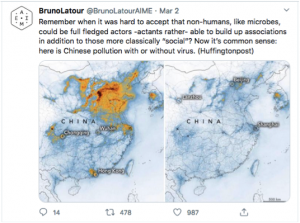
If the governmental edict of social distancing, paradoxically, wants to promote solidarity on the basis of its opposite, namely a dissolution of the social fabric, Latour has argued that a new system of engendering, which might replace the unsustainable, modern system of production, must rely on a principle of interdependency; that is to say, an acknowledgement on ‘our part’ that all biotic (and abiotic) agents are entangled within a precarious ‘critical zone’ of life. The modern system of production is indicted for making a false promise: to grant humanity ‘freedom’ of a life of hardship and inequality by raiding the pantry of nature. We must now all share the collective guilt of this colonizing act or else this ‘freedom’, which is based on an economic and juridical system of ‘property rights,’ is liable to become twisted into such perverse forms as the protests of far-right groups against the lockdown, chanting that they want to ‘liberate’ certain states in the U.S.A. or, as in Berlin, proclaiming that ”Wir sind das Volk.” It is exactly such a denial of dependency on others, which are not only of a human kind, which leads white supremacists to promulgate their paranoia about the ‘great replacement’ or, in the same breath, to deny the reality of climate change.
Whereas Latour’s notion of an engendering crisis does allow one to make a connection between seemingly disparate political issues, from immigration to the environment, the sticky point, as always, is how his critique of modernity might translate into an actual political practice and to what extent in its overarching, holistic approach too quickly evacuates other forms, possibilities and necessities of dependency and solidarity. But I shall not dwell on that question here; rather, I would like to return one last time to the figure of entanglement, as at the bottom of Latour’s thinking, even before the emergence of his famous “actants,” lies a great, submerged realm of the informe; a realm of almost sheer virtuality, at the very edges of life itself, in which an enormous, continuous exchange of genetic material takes place. “I am thunderstruck,” Latour tells an interviewer, “by the speed with which, particularly in biology, questions to do with the superposition of cells, entanglement, the return of halobionts, symbiosis (especially that of Lynn Margulis) are causing a rethink of a whole range of accepted positions on the philosophy of life.”[5] Latour is referring to What is Life, authored by Lynn Margulis and Dorion Sagan, which provides a groundbreaking account of the “bacterial biosphere,” which not only preceded all other species of life, but also enables all other species of life. It is, in their words, like one “global growing being” in which cells never age, but constantly swap gene material, altering themselves and their environment in the process. A notion that is worthy of the best narratives of science fiction as they claim. “The entire planet is bacterial. Human technologies and philosophies are permutations of the bacteria.”[6]
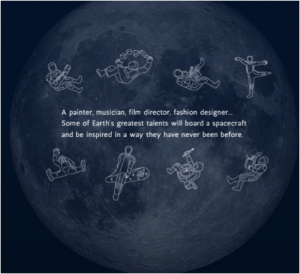
And this should be a warning to those who would like to join that other group, which has perverted the meaning of ‘freedom’ within the system of modernity; those, that is, who Latour dubs ‘hyper-neo-modernists’ and want to escape the engendering crisis by leaping off earth into outer space. Think here of Elon Musk’s Mars Mission, which presumably would export the modern system of production to an as-yet ‘barren’ planet, while leaving all harmful ‘bio-agents,’ whether rebellious people or virulent pathogens behind. The key to survival is to create soil and to create soil you will need to inseminate Mars with a bacterial biosphere. But it would form a mistake to believe that it is ‘us’ that is in control here. A startling discovery by astronauts on the International Space Station is that microbes have thrived in the interior of the space station, but that even on the exterior of the space station, bacteria and viruses are able to survive for several weeks. ”Everywhere you go, you bring your microbes with you,” a researcher stated. ”Astronauts are exceedingly healthy people. But as we talk about expanding space flight to tourists who do not necessarily meet astronaut criteria, we don’t know what will happen. We can’t say that if you put someone with an infection into a closed bubble in space that it won’t transfer to other people. It’s like when someone coughs on an airplane, and everyone gets sick.”[7] Musk would like to fund his Space X rocket project by means of high-rolling guests, such as the Japanese fashion entrepreneur and art collector, Yusaku Maezawa, who in turn wants to invite several artists for a fly-by of the moon.[8] “Together with Earth’s top artists, I will be heading to the moon… just a little earlier than everyone else,” as apparently not just the earth’s natural resources, but our creative imagination has been severely depleted and needs a jolt by zero-degree gravity. Literally putting the ‘global’ literally into globalized art, this must be the most expensive, and wasteful art project too date. The trip also comes too late, despite Maezawa’s neo-modernist ode to a cosmonautic art: We already have enough objectifying images of the ‘blue marble’ which may have done as much harm as good to our understanding of the earth as ecological system. We don’t require any more “out-of-this-world” attractors, as Latour put it, but need to land in the thick of geo-history, down here on earth amongst those other actants that don’t get to take flight.[9] At this point, it does not seem all too likely that a lift-off will take place, according to plan, in three year’s time. If only because Maezawa had to sell off part of his art collection to pay for his lunar ticket.
Yet Maezawa’s misfortune did not stop art dealers from buzzing last fall about the potential entry of another, deep-pocketed media entrepreneur onto the art market. At a Christie’s auction, Jeff Bezos apparently bought two paintings, one being Edward Ruscha’s Hurting the Word Radio (an apt title for a CEO who prides himself on ‘disrupting’ older technologies). If there is one economic sector that stands to do well in the current crisis, it must be e-commerce, digital streaming and social media. Even so, the new media moguls have been relatively sparing in their donations to fight the pandemic. (Not, of course, that we should want to have to depend on their charity.) A few are giving back, if in a relatively sparing manner.[10] According to the most recent figures, the amount that Bezos has given – $100 million to a food bank – is only 0.1 % of his estimated $123 billion fortune or the equivalent, for him, of buying circa three paintings at auction. Musk, not surprisingly, is not even mentioned in the article. But before he amasses further wealth off social distancing, allowing him to finish his Noah’s ship, he may do well to read the cautionary tale of another space ship, which does proper justice to the sci-fi character of the bacterial biosphere, as noted by Margulis and Sagan noted, if not quite how they might have expected such a narrative to be spun.
The 2015 novel Aurora by Kim Stanley Robinson follows what at first seems like the well-worn plot of a generation ship, sent to colonize a planet in a distant solar system. The expectation was that “Aurora” would be no more than an ‘empty ecological niche’ ready to be injected with terrestrial bacteria to convert its ‘barren’ terrain into a livable environment. . Things go badly, however, when it turns out the moon already carries primitive life in the form of prions that proved deadly to humans. The despondent crew must then turn the ship around and head back to earth if they are to survive. But it is only then that plot begins to thicken. Life on the ship began to change: “Then also, as there were thin films of bacteria (also viruses and archaea) covering every surface of the ship…the ship was indeed alive with microbial life… the living nature of the ship’s interior became something ominous and foreboding.” As there was no of sterilizing the ship without threatening the food and oxygen resources of the crew, they “simply had to live in a rich broth of bacteria, in a cumulative microgenome that was so much larger than their own genome that it was beyond a complete reckoning, especially as it was fluid and always changing… all the ship’s walls, windows, framing, gears, and glues had been altered by bacteria, first chemically and then physically and mechanically, impairing their function.” A gradual metabolism of the ship’s elements – metal, glass, plastics – was set in motion. The ship was not only alive – in a way where humans hardly counted – but it was getting eaten. “Which meant that in some respects, the ship was sick.”[11] Not only does this provide a perfect re-description of Space Ship Earth for present times, it should also warn those hyper-neo-modernists that they live by grace of the ‘microbial biosphere,’ not the other way around.
[1] Anita Singh, “Cambridge University students cry fowl over 17th century painting that upsets vegetarians,” The Telegraph (November 21, 2029).
[2] David Fickling, “China is Opening its Wet Markets. That’s Good,” Bloomberg.com (April 4, 2020).
[3] Eric Quintanar, “Bloomberg Publishes Gushing Article About China’s ‘Wet Markets,’ Compares Appeal To Farmers Markets,” Daily Wire (April 4, 2020).
[4] Giorgio Agamben, “Wir sollten uns weniger sorgen und mehr denken,” Neue Zürcher Zeitung (April 7, 2020).
[5] “Issues with Engendering, Bruno Latour interviewed by Carolina Miranda” (Revue du crieur N° 14, La Découverte/Mediapart, 2019. “Carolina Miranda could be a Chilean ethnologist and documentary filmmaker. They might have met on the 10th of June 2019 in Chatelperron. The form of the spoken language has been retained as much as possible. Translated by Stephen Muecke”) available at http://www.bruno-latour.fr/sites/default/files/167-TROUBLES-Engendering-GB.pdf
[6] Lynn Margulis and Dorion Sagan, What is Life? (Berkeley: University of California Press, 2000), p. 97.
[7] Amanda Morris, “Space microbes aren’t so alien after all,” Science Daily (January 8, 2019).
[8] Sam Levin and Justin McCurry, “Elon Musk to launch Japanese billionaire on Space X rocket to the moon,” The Guardian (September 18, 2018); https://dearmoon.earth/
[9] Bruno Latour, Down to Earth: Politics in the New Climatic Regime (Cambridge: Polity, 2017), p. 43.
[10] Rupert Neate, “Call for super-rich to donate more to tackle coronavirus pandemic,” The Guardian (April 11, 2020).
[11] Kim Stanley Robinson, Aurora (London: Orbit, 2015)